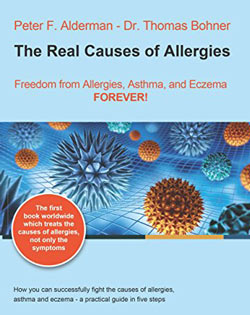|
|
Could man-made enzymes be the missing link in the allergy epidemic? Peter Alderman and Dr Thomas Bohner think that they could. Michelle Berriedale-Johnson elucidates. |

Allergy is normally defined as an inappropriate reaction of the immune system to an otherwise harmless substance. But is that actually correct? Could allergy not be better defined as a totally appropriate reaction of the immune system to a substance that, as long as it remains outside the body, is harmless but is no longer harmless once it has been absorbed through the skin into the bloodstream? A leaky gut – gaps in the tight junctions between the cells that form the mucosal lining (the internal 'skin') of our digestions – is known to allow undigested, and potentially allergenic, proteins into the bloodstream thus setting off either allergic or intolerance reactions. The same can happen with the skin in the respiratory system or our 'outside' skin. If it does, substances such as pollen which are harmless as long as they remain outside our bodies, cross the skin 'barrier'. Once across they are seen by the immune system as 'foreign' and dangerous and it therefore goes into action to expel them. Such is the theory of Peter Alderman and Dr Thomas Buhner, authors of The Real Causes of Allergies and manufacturers of the Kalixan range of super freefrom detergents, anti-mite and enzyme free products and air filters. However, their theory does not stop there. And it is the second leg to the theory that has led them to the creation of their products. Killer enzymes Enzymes are a very large group of proteins, crucial in the functioning of the human body. They act as biochemical catalysts and without them our metabolisms, such as our digestions for example, would simply not function. Natural enzymes, which are only formed in very low concentrations, are not consumed during the reaction and are very dependent on temperature. They cannot survive above 45 degrees centigrade. They work best when their pH value corresponds to their natural environment. There are many thousands of natural enzymes at work in the body, each of them specific to one biochemical process only. In the late 19th century it became possible to create enzymes in a laboratory, usually 'grown' from biologically and genetically modified fungi and microbes. These included heat resistant enzymes (that can tolerate any temperature from below freezing to above boiling), enzymes that are not pH value sensitive, enzymes that are highly concentrated and enzymes that are non specific and therefore multi tasking. Many of these enzymes are designed to split or modify substances – such as splitting the fats in a stain so that it washes out easily. But because they are multi-tasking they can split not just the proteins in the fat stain on your shirt, but any proteins they encounter – such as the proteins which form the 'tight junctions' between the cells in our mucosa. If this happens the junctions are no longer tight and, as in leaky gut syndrome, proteins which were never designed to breach the skin barriers (such as pollens or undigested food proteins) reach the blood stream. Moreover, these engineered enzymes can not only destroy, and thereby breach, the tight junctions in our skin and gain access to the blood stream. They can cause further damage as they can also split immunological receptors such as the IgE and the IL-2 receptors thus disrupting the immunological reaction. Manufacturing processes Although these manufactured enzymes are extremely widely used in almost all processed foods and in detergents, because they are 'manufacturing aids' they do not need to be labelled. The industry claims that no damage is caused to consumers as the enzymes are 'de-activated' by heat during the manufacturing process (even though many are known to be heat resistant) and that anyhow, so little of them remain in the food or the wsehd clothes that they could do no harm. It goes without saying that Messers Alderman and Bohner do not agree. How did they come up with this theory ? Peter Alderman, an IT specialist, had suffered all his life from respiratory allergies. Through trial and error, he found that, if he could eliminate all products which contained man made enzymes from both his diet and his environment (by eating a Stone Age, manufactured-food-free diet and using no common detergents) after 5 days his allergy symptoms would disappear. But if he then started to eat food containing man-made enzymes, or otherwise come into contact (through washed bed linen or clothes) with man-made enzymes, within 5 days his allergies would be back. Now, 20 years later, he remains (as long as he keeps to his regime) allergen free. But he has spent that 20 years researching his theories, writing them up with Dr Thomas Bohner (in The Real Causes of Allergies) and developing a range of homecare products which are enzyme free. A fascinating theory... If you want to read more the book is available from Amazon here as a Kindle or via Amazon CloudReader if you do not have a Kindle. You can read more about their products here. May 2017 Click here for more articles on causes of allergy
|












